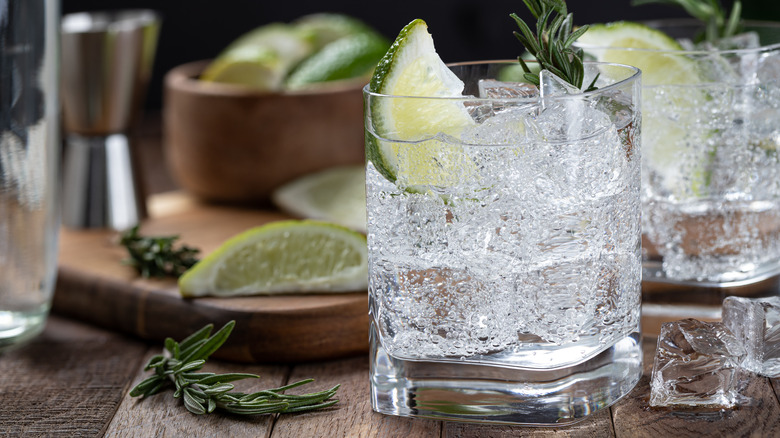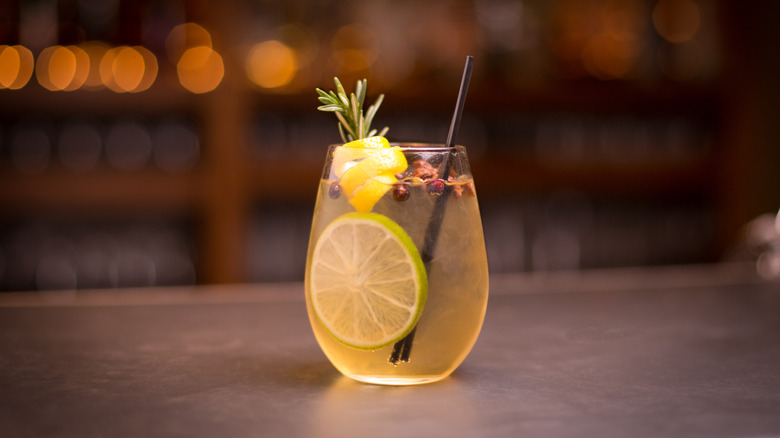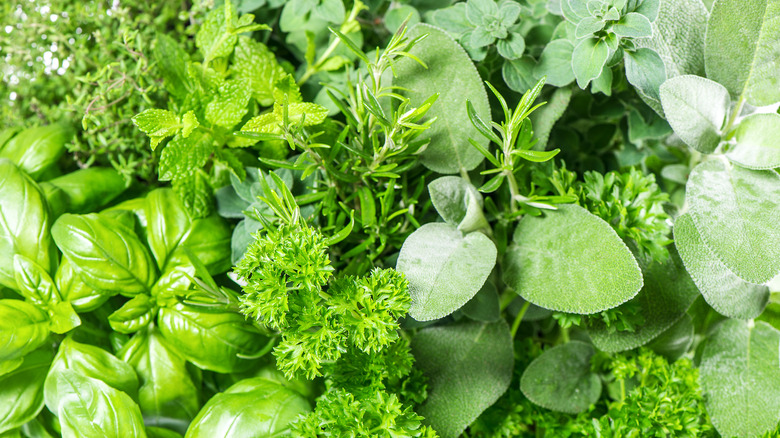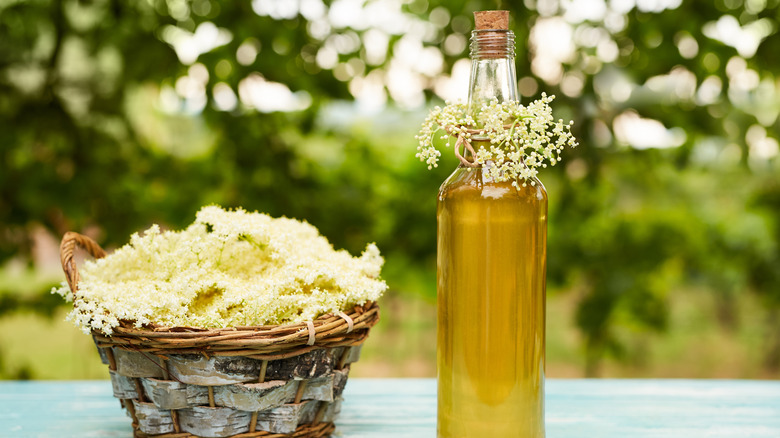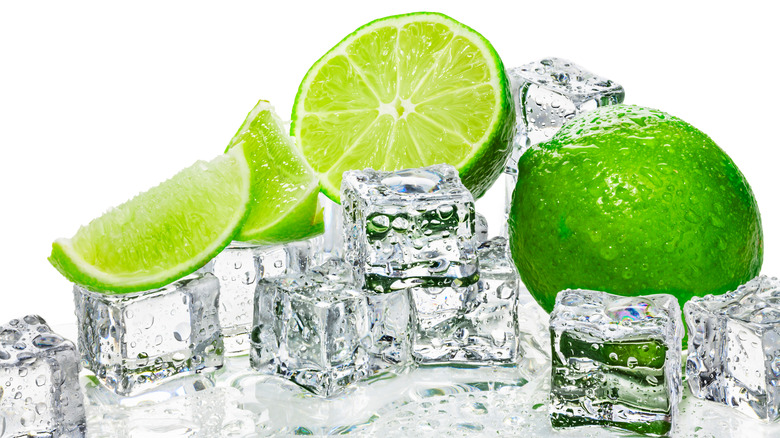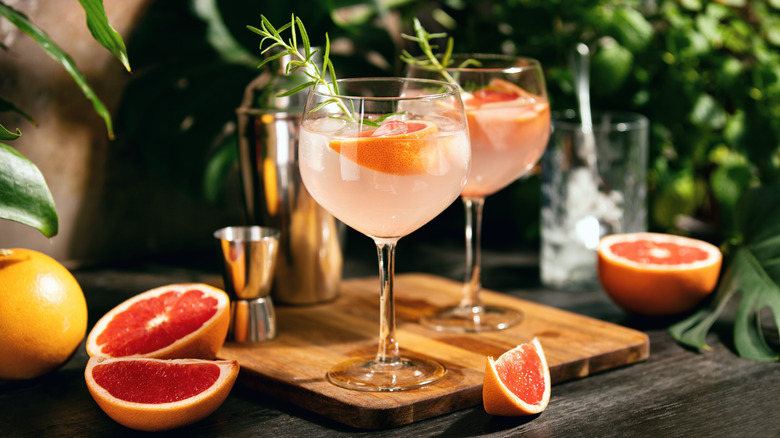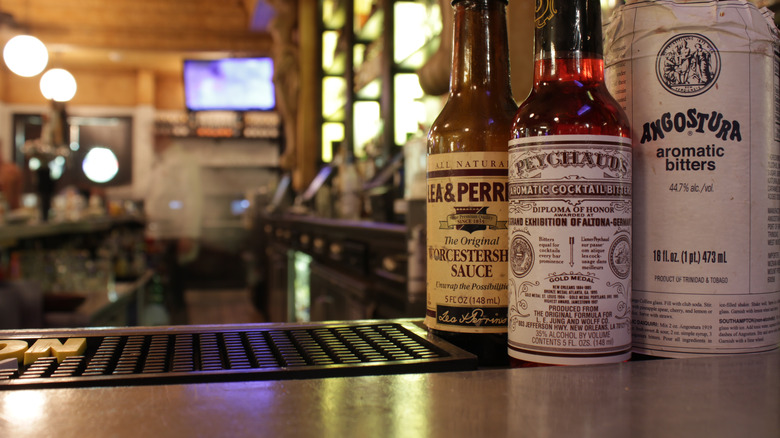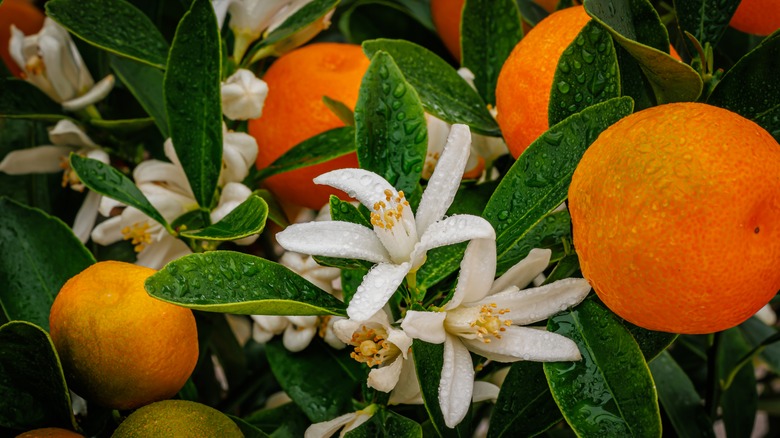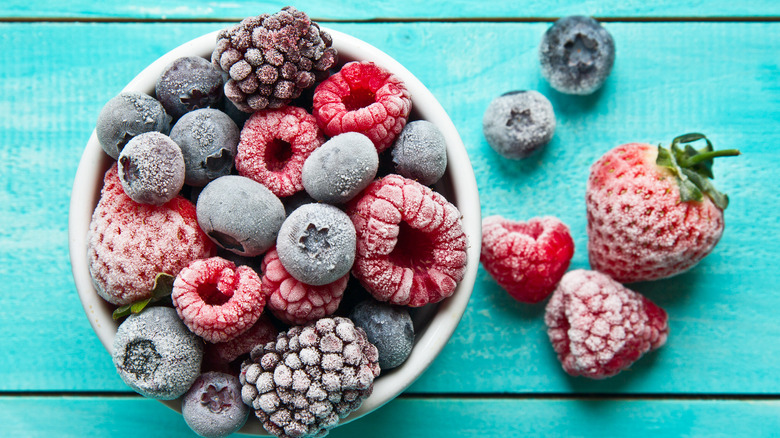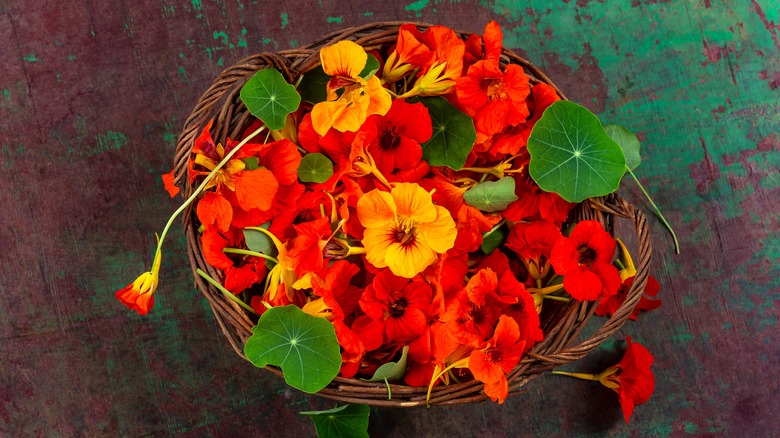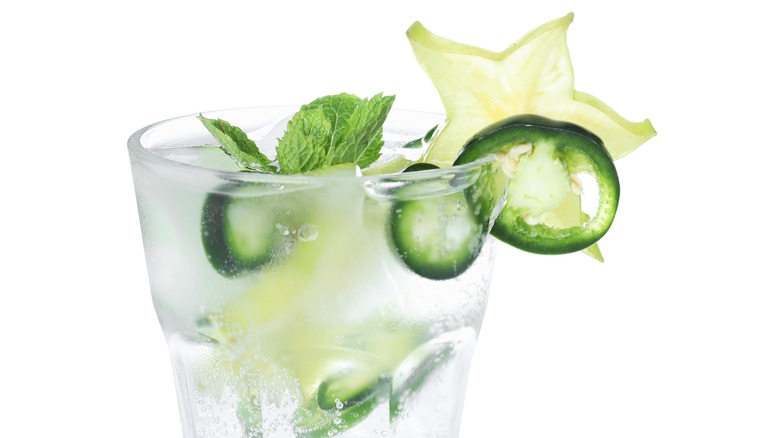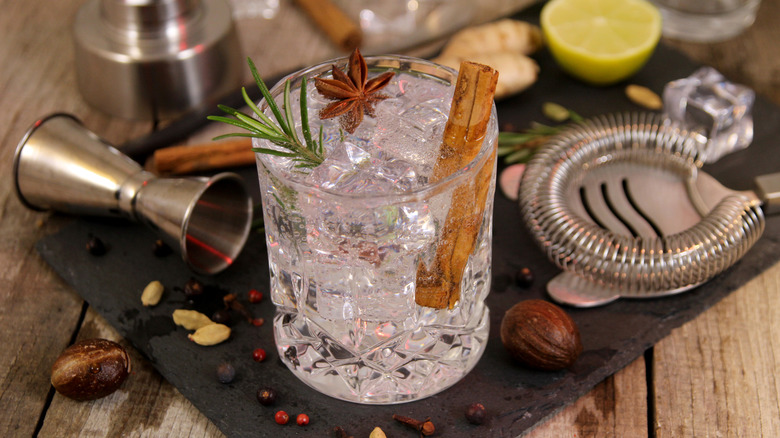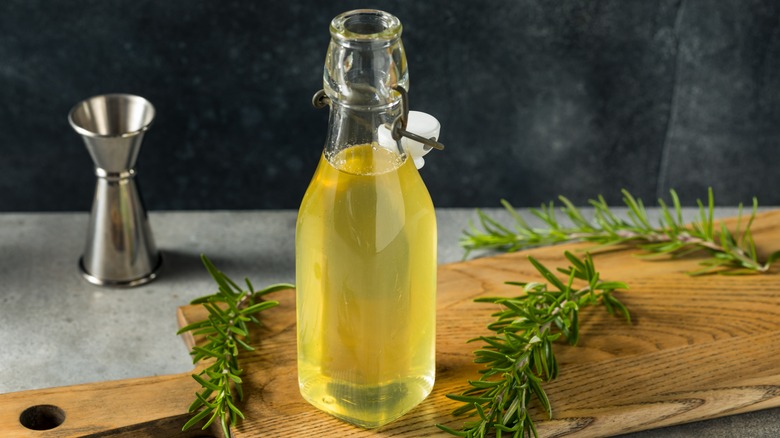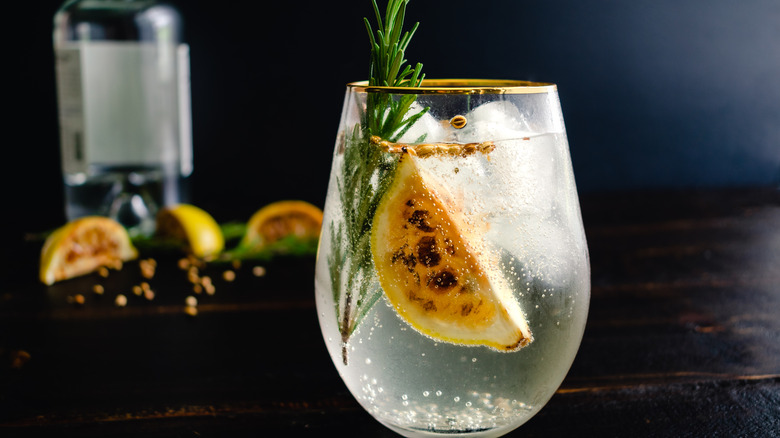13 Ways To Upgrade A Gin And Tonic
The gin and tonic isn't a cocktail that appeals to everyone. Quinine has a bitter flavor, while gin's juniper notes can be overpowering to some people's pallets. Quinine was originally served to the British armies in India during the 19th century to prevent malaria. The soldiers would often add gin and citrus to help the proverbial medicine go down, as the flavor of straight quinine was unpleasantly bitter. These days, the gin and tonic and its various iterations can be found on cocktail menus across the globe. It has come a long way from its origin, and it's had a few glow-ups along the way!
Simple and classic, elegant while still casual, the gin and tonic is the little black dress of cocktails. You can dress it up with botanical accessories for a fancy night out or enjoy it at its most basic at a backyard barbecue. When you have a drink that requires only two ingredients, there's plenty that you can do to elevate both its visual presentation and flavor while still maintaining the simplicity that embodies the G&T. You'll find that it doesn't take much to really make your gin and tonic stand out.
Make it from scratch
If you want to really craft your cocktail, you can actually make a gin and tonic from scratch by infusing your own gin and creating your own tonic. This gives you a lot of control, allowing you to tweak the flavor depending on what level of botanical, citrus, or fruit appeals to your pallet.
Gin is surprisingly easy to make yourself, provided that you have access to a sous-vide cooking device. Sous-vide cooking is a method of cooking by submerging the ingredients in water and heating them to an exact temperature slowly. The slow and low cooking process is fantastic for infusing flavors without cooking off the alcohol that's in the vodka you'd be using as your base.
Combining botanicals yourself gives you absolute freedom of flavor. You may want a more lavender-forward gin rather than have the juniper take center stage. All you need to do is increase the desired herb or spice, and you're on your way toward having a truly personalized spirit at your fingertips that will really impress your friends.
Garnish with fresh herbs
If you want your cocktail to truly come alive, bring a bit of your garden to your glass. Gin is uniquely suited to be complimented by a plethora of herbs, given just how botanical its profile is. Rosemary and gin is not only a fantastic flavor combination, but the visual appeal of a sprig of rosemary extending out of a glass is also both elegant and stunning.
Mint, thyme, and basil are other herbs that can either be muddled into your cocktail glass or added as a finishing garnish. All of those herbs have notes that play off the pine-like flavor of juniper, the main component of gin's flavor. Bruising the leaves of the fresh herbs gently is enough to release their oils into the cocktail and bring that vivacious flavor to your cocktail.
If you want to really bring the drama, carefully ignite the end of the rosemary sprig with a lighter, then immediately blow it out. Lay the smoking sprig across the glass so that the fragrant smoke will waft onto the cocktail. The smoky flavor will be both an herbaceous boost and also an eye-catching display when you serve it up.
Get botanical by adding elderflower liquor
Elderflower liquor is a surprisingly recent creation, invented in 2007 by a distiller named Robert Cooper. It's a spirit that is made with fresh elderflower blossoms, picked at the height of their season, and infused. Its sweet, floral profile pairs exquisitely with the botanical base of gin.
Adding a splash of elderflower liquor to your gin and tonic will sweeten it right up, taking the edge off the quinine flavor of the tonic. Elderflower plays nicely with many different gin and tonic companions, such as fresh herbs, citrus wedges, and other florals like lavender. Adding a drop of this sweet liquor is a perfect way of easing a new gin drinker into the world of gin-based cocktails. It highlights all the flavors of the gin and tonic while keeping the overall experience much more mellow and easier on the pallet that the traditional recipe. It's like adding in a splash of springtime to every cocktail.
Make lime or cucumber infused icecubes
Ice is a major component of a good gin and tonic. You want the tonic to be nice and cold while you're sipping on it. But why settle for plain ice cubes? Improve your cocktail game by making your own infused ice cubes!
It's really your call on how you want to dress up your ice, but squeezing in a bit of lime juice before sending them to deep freeze is a great addition. You could also slice paper-thin wheels of cucumber and put them into the ice cube mold along with the water. Cucumber is a subtle and refreshing note that plays beautifully with gin. As the ice melts, the infused flavor is released into the cocktail, giving it layered notes as you drink it.
For an even more striking appearance to your ice, you could freeze mint leaves, small rosemary sprigs, or lavender buds into the cubes, letting the florals take center stage in the cocktail glass.
Use different varieties of citrus
The bright and tangy notes of citrus are an integral part of bringing the zing to your G&T. The traditional pairing is a slice of lime, and there's nothing quite as iconic as a bubbly glass filled with ice, tonic, gin, and that bright green wedge.
However, don't limit yourself to one citrus fruit. Grapefruit has become increasingly popular as a companion to gin. The rich, vibrant flavor of grapefruit compliments the floral tones that you find in botanical gins. The ruby-red flesh of the grapefruit is stunning against the sparkling backdrop of the cocktail. Blood orange is another strikingly colorful citrus whose flavor will set your gin and tonics above the rest.
If you want your cocktail to really stand out, slice kumquat into paper-thin wheels or into chunky quarters, and float them in your gin and tonic. Small in size and unique in flavor, kumquats are a fun garnish that you might find yourself returning to again and again because they're so enjoyable.
Use a dash of uniquely flavored bitters
Bitters are having a renaissance recently. Ten years ago, a trusty bottle of Angostura bitters was all a bartender really needed to add a finishing note to their cocktails. These days, a well-stocked bar will have a plethora of flavored bitters. Bitters now run the gamut from traditional orange, to chocolate, to floral, and even savory flavors. Each bitter variety has its place in the world of crafting cocktails, and you can really experiment with all the variety of bitters that are available these days.
Adding a few drops of unique bitters is an easy way to elevate your gin and tonic. You can highlight the floral tones of your gin by adding hibiscus or lavender bitters. Fruit bitters are also very popular, with options such as pear, cranberry, and plum. The beauty of bitters, too, is that you can add as much or as little as you want. You can also layer your bitters to build up a more complex flavor profile for your gin and tonic.
Add orange blossom or rose water
If you want to add some additional flavor, but don't want the intensity of bitters, you might want to try mixing in a splash of orange blossom or rose water. These old-timey, essential-oil-rich ingredients bring Prohibition-era charm along with amazing fragrance. Much like orange bitters, orange blossom water provides a delightful citrus flavor. Adding a splash will give your gin and tonic an orangey boost with less of the bitter zing that traditional bitters provide. Orange blossom water also provides floral notes as well, lending even more botanical fragrance and flavor to your cocktail.
The Cocktail Society recommends rose water for gin cocktails because of how floral it is. A small amount of rose water will turn up the dial on your botanical G&T. A little bit will go a long way in a cocktail, so only add a few drops at a time and taste your mixture often! Both orange blossom and rose water are found in Middle Eastern cuisine and can tie together your cocktails and your main courses by playing beautifully with both spicy and sweet foods. Pair an orange blossom G&T with tagine chicken or lamb shawarma to make the whole meal come alive.
Freeze fresh berries and use them instead of ice cubes
A gin and tonic is not perfect unless it is served ice cold. The chilly tonic seems even more effervescent, and the gin's botanical flavor really sings when it's chilled. So having plenty of ice is a must if G&Ts are on the menu. However, you can add some real eye-catching beauty and fruity notes to your cocktail without watering it down by using frozen fresh berries instead of ice cubes.
Chunky strawberries, delicate raspberries, and even tart cranberries all make ideal icy garnishes for your gin and tonic. Blueberries and blackberries are also excellent additions. The bright pop of color, along with the slow release of the berry flavors, will keep the gin and tonic flavor evolving as you sip on it. Plus, you end up with delicious, gin-infused fruit to enjoy once the cocktail is gone.
To ensure your berries are 'gram-worthy, you want to make sure that you freeze them correctly. Wash them, gently pat them dry, then spread them out in a single layer on a sheet pan before freezing. This will ensure that your berries aren't stuck together in a mushy lump as they thaw. You're able to drop in individually frozen berries, and your cocktails will look straight out of a photo shoot.
Get really floral with edible flowers
If you really want to bring the botanical garden to your cocktail-making, then why stop at just the flavor? Why not add the whole flower? There are tons of edible culinary flowers that are not only beautiful but also elevate the flavor of your drinks, as well.
The sweet, honey-like flavor of lilac blossoms would be right at home in a gin and tonic. A sprig of lilac or a float of rose petals will make the floral flavors of the gin really pop. You can even steep hibiscus blossoms in your gin to impart a tart flavor and a gorgeous tint of red color.
Not all flowers are necessarily the traditional "floral" flavor that you imagine. Nasturtiums have a peppery flavor, similar to arugula, which can steer your gin and tonic in a more savory direction. Pair your peppery G&T with your steak dinner to really tie everything together. Wood sorrel is lemony in flavor, which is perfect in a gin and tonic. If you want to lean a little more herbal, add some pretty chamomile blossoms to float in your glass while you sip, letting their fragrance imbue a calming sweet flavor.
Bring the heat with chilis
Spicy cocktails started showing up on menus about ten years ago and they haven't left, proving that heat is here to stay. While tequila is often the spirit that you find paired with chili peppers, gin also benefits from a touch of spice.
Jalapeno peppers are often the garnish of choice for a spicy cocktail. They tend not to be the hottest of peppers while still having a bit of a kick. And you can make them even less spicy by stripping out the seeds and inner membrane where the true heat lurks. You can freeze the jalapeno rings into ice cubes, allowing the heat to seep into your cocktail as you sip slowly. Or you can float them in the drink along with cooling cucumber slices to tame the flame.
Hot honey is also an ingredient that you can swirl into your G&T to give it a kick. The pepper-infused honey delivers both a sweet boost and also a peppery warmth that will bring the best of both worlds to your gin and tonic game. A spicy G&T would be an awesome departure from margaritas on your Taco Tuesdays!
Go sweet with cinnamon and chai flavors
Gin and tonics might strike you as a summery beverage, but you can carry this versatile drink into the holiday season as well. Use a cinnamon stick to stir your ingredients together and float a star anise pod amid the bubbles. It might strike you as a strange combination, but actually, there's a reason these spices play well in gin.
When gin is infused during the distilling process, it gets its botanical flavor from a myriad of sources. Juniper tends to be the most forward note, but juniper berries are just one of many, many spices that make gin distinct. Among the other ingredients, you'll find caraway, anise, cardamom, cloves, and fennel. Though these flavors might not be the first to hit your pallet, by garnishing with additional spices, you'll be highlighting those layered flavors.
Quinine is a bitter-tasting beverage, medicinal in flavor. The spices that you might find on your baking shelf add not only a beautiful flair but a warming flavor that might cement gin and tonics as a go-to holiday beverage.
Infuse some honey and botanicals into a simple syrup
Simple syrup is, you guessed it, very simple to make. At its heart, it's nothing more than reduced sugar water. However, as we're learning with the humble G&T, even the simplest of ingredients can be elevated to bring some magic to your cocktails.
A standard recipe for simple syrup is just equal parts sugar and water that is heated in a pot until the sugar fully dissolves. You can replace some of the sugar with honey to bring that golden honey flavor to your syrup. You can also add fresh herbs and botanicals to the pot. Rosemary springs, stalks of thyme, or branches of lavender can be added while the sugar dissolves to infuse the floral, herbal flavor into the syrup. Once you've cooled the syrup, you can add a splash of it into your gin and tonic to take an edge off the bitterness and also imbue more botanical flavor into your cocktail.
Fruit is another addition to simple syrup, which can really improve your gin and tonic recipe. Orange, lemon, or even cucumber will impart their flavors into the syrup as you cook it down. When you add a tipple to your G&T, you'll find yourself wanting to make a variety of simple syrups to keep your bar game on point.
Char your fruit garnish to impart a sweet and smoky flavor
If you really want to make your gin and tonic the height of sophistication, don't settle for a raw fruit garnish. Throw your lemons, limes, pineapples, and grapefruits right onto a hot grill.
The charring of the fruit brings out the juices, meaning that when they hit your cocktail, you're going to get more of that fruit flavor into your drink. The caramelization also adds a layer of additional interest, both visually and to your pallet.
If you're not right next to a grill, you can still get a nice charred finish on your fruit by busting out a crème brulée torch and running the flame over the fruit until it starts to blister. This not only looks cool while you're doing it, but it will also awaken the oils in the fruit rinds, meaning that you'll be smelling the fruit when you sip, improving the overall flavor of the drink.
